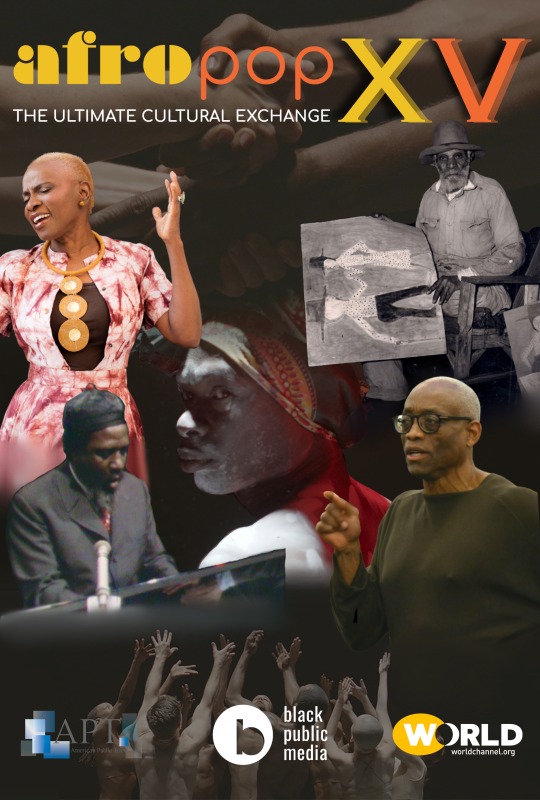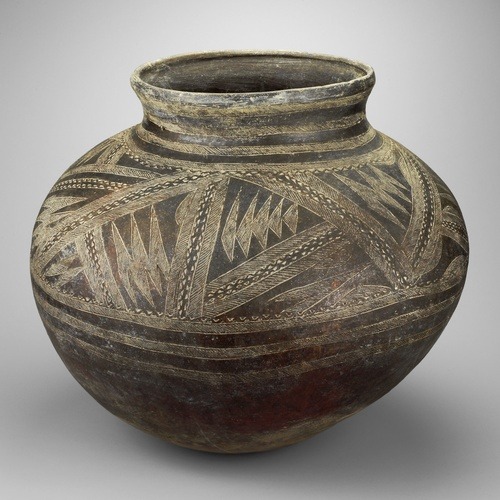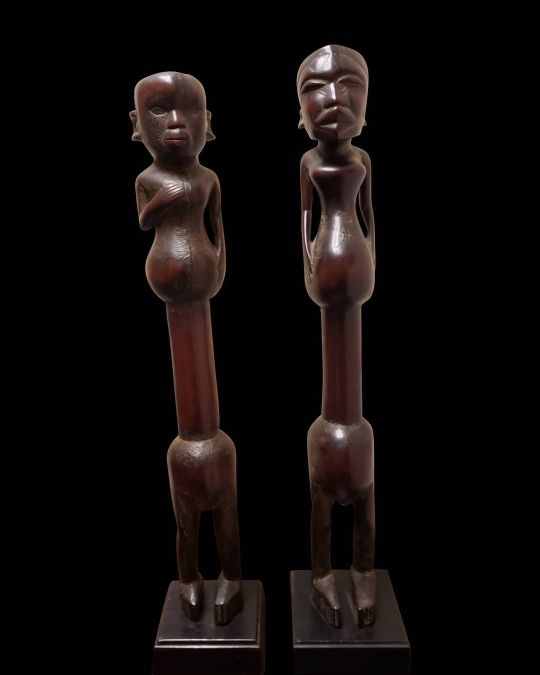#makonde art
Text
Please reblog for a bigger sample size!
If you have any fun fact about Mozambique, please tell us and I'll reblog it!
Be respectful in your comments. You can criticize a government without offending its people.
43 notes
·
View notes
Text

“The Makonde traditionally made large beer or water vessels decorated in a manner unrelated to neighboring groups in Mozambique and Tanzania. The surface of the silvery pots is finely etched in often-complex, interwoven patterns that use curvilinear, geometric, and floral motifs. After firing, the patterns are rubbed with kaolin to accentuate the designs.
This Makonde vessel is unusual in its simplicity and elegance of form.
The slight bulge of the shoulder makes the pot seem inflated. The clay body contains a significant amount of mica, which causes the surface to slightly sparkle.
22” × 24” Schaedler, 1997. 314) (cf. Stößel 1984, 183 pt.23)
From: “the art of African clay” by Warren Frederick and Barbara Thompson; 2003.
10 notes
·
View notes
Text


More for #InternationalZebraDay:
Zebras by African TingaTinga artist Steven Mkumba (Makonde, b. 1965). Both oil/acrylic/ink on canvas, made in Tanzania in association with the Tingatinga Arts Cooperative Society.
1. Mkumba's Zebra, 2020 https://tingatingaart.com/products/mkumbas-zebra
2. Stripes and Pride, 2019 https://tingatingaart.com/products/stripes-and-pride
More about the TingaTinga school of art here.
#zebra#zebras#mammals#painting#TingaTinga#African art#Tanzanian art#Tingtinga Arts Cooperative Society#contemporary art#Steven Mkumba#International Zebra Day#animals in art
18 notes
·
View notes
Text
Angélique Kidjo, Bill T. Jones & Thelonius Monk Documentaries Are Scheduled For Season 15 Of AfroPoP: The Ultimate Cultural Exchange

Documentaries about African singer Angélique Kidjo, choreographer Bill T. Jones and jazz musician Thelonious Monk are scheduled for season 15 of AfroPoP: The Ultimate Cultural Exchange. The new season is different from previous ones because it focuses on one theme by singling out Black art for the first time. The WORLD Channel has been the home and co-producer of the show with Black Public Media since 2010. Leslie Fields-Cruz, BPM executive director and AfroPoP executive producer had this to say about their 15th anniversary:
“When we created AfroPoP: The Ultimate Cultural Exchange it was our hope that we would be able to bring stories of modern Black life to public media audiences and help augment viewers’ ideas of what Black life is and can be,” said Leslie Fields-Cruz, BPM executive director and AfroPoP executive producer. “Witnessing the series reach its 15th season, a landmark that is the result of the work and drive of so many people over the years, is an awe-inspiring and humbling moment that fills me with great gratitude.”
The premiere of Can You Bring It: Bill T. Jones and D-Man In The Waters will stream exclusively on Black Public Media's YouTube Channel at midnight ET on Monday, April 3rd. The film will screen later on that day at 8 PM ET on WORLD Channel. The feature looks at the ballet D-Man In The Waters originally presented in 1989 by Jones and his late partner Arnie Zane. The ballet was created in response to the A.I.D.S. crisis at the time and its impact on their dance company and friends.
Claire Duguet's Queen Kidjo will screen on April 10th. The film follows Kidjo's beginnings in Benin and her rise to legendary status. Bill Traylor: Chasing Ghosts is a portrait of the painter Bill Traylor who was born a slave and started painting scenes of his life on a plantation and the changing urban world at age 85. Jeffrey Wolf's film about Traylor is scheduled for April 17th. The Sound Of Masks is about a Mapiko dancer from Mozambique. The Mapiko dance is exclusively performed by male members of the Makonde community as a tool of independence to defy the colonizing influence of the Mozambican War Of Independence. Sara CF de Gouveia's feature about Mapiko is scheduled to be seen on April 24th. Rewind & Play is Alain Gomis's exhibit of the disrespect jazz pianist and composer Thelonius Monk experienced in 1969 during an appearance on French state television. Rewind & Play will air on May 1st. AfroPoP has been presenting
AfroPoP: The Ultimate Cultural Exchangecan also be viewed on WORLD Channel’s YouTube channel and on all station-branded PBS platforms, including PBS.org and the PBS Video app. The program is available on iOS, Android, Roku streaming devices, Apple TV, Android TV, Amazon Fire TV, Samsung Smart TV, Chromecast and VIZIO. APT will release the season to public television stations across the country on Monday, May 1. For viewing information, check local listings.
youtube
youtube
youtube
youtube
youtube
#afropop: the ultimate cultural exchange#bill traylor#angelique kidjo#thelonius monk#black public media#mapiko#Youtube
2 notes
·
View notes
Text

NDIMU | BELLY MASKS🤰🏿💐
The Makonde are a Matrilineal society. They adhere to an ancestress-based spirituality.
.
In Tanzanian African art, these bodymasks called Ndimu represent pregnant women.
But this type of mask is actually worn by men during initiation festivities after they return to the community from separation in their coming of age rituals. After these initiations men can take wives and father children.
.
The men will use these in dance and performance to demostrate sex, the course of pregnancy, and the throes of childbirth.
.
The idea of men being present and invoking the spirit of maiden to mother while transitioning into their own mature forms is beautiful. I think this is a way Makonde culture holds space for women in the community.🌀🌟🖤
2 notes
·
View notes
Text
SMALL HANDMADE DECORATIVE MAKONDE STYLE ONE-PIECE EBONY SCULPTURE
When it comes to statues or decorative carvings, the first and most important step in the creation process is the choice of wood. It is the wood that dictates the shape and approximate dimensions of the piece of jewellery that will emerge from the hands of the African sculptor.
That’s what happened here, and the whole piece of ebony – one of the most precious types of wood in the world – became a genuine piece of African tribal art, hand-carved in the Makonde style.
This style is defined by the life of the man and his relationships within the tribe, and the harmony in life is found in the harmony of the carved forms and elements, no matter from which angle they are viewed.
And regardless of the space in which they are placed to be admired and appreciated by lovers of African-style beauty.
Strong short reasons to have it:
Unique piece of furniture
Unique concept
Special design: mix of African art and European/British design
High quality
Fine details expressing elements of tribal life
Long-term investment
About the artwork:
Wood: ebony (single piece)
Artist: Isiaka Deje
Team involved: 3 members
Completion time: over 3 months
Carving style: Makonde
Height: 60 cm
Diameter: 16 cm
Weight: 3 kg
Good to know: By purchasing any Venda Art product, you are supporting us in our efforts to help as many vulnerable people in Africa as possible, both through healthcare, access to education and support in improving their quality of life. We, and those who will benefit from your help through us, thank you!
https://vendaart.com/product/makonde-2-sculpture/

0 notes
Text
I’m so happy because I’m taking an African art history class and I just had to write an essay about a piece of art, literally just describing what it looks like, and the piece I chose was a Makonde belly mask so I got to pull out all the anatomical directional terms and I love it so much 💞💖
#art history#african art#belly mask#Tanzanian art#makonde art#anatomical terminology#directional terms
1 note
·
View note
Photo

Mask, 1950s, Minneapolis Institute of Art: Art of Africa and the Americas
Helmet Mask, wood and hair, full head tilted slightly upwards, fully scarified face and geometrically shaven head. Before Mozambique won its independence from Portuguese colonialism in 1975, Makonde men and women significantly modified their bodies in the name of beauty, as shown on this mask. The modification began at puberty as an important step toward maturity and cultural belonging, enlivening the face and framing the features with tattoos, chipped teeth, and a shaved hairline. Men wore wooden masks like this one at public dance performances, accompanied by drummers and a chorus. The carved hair comb and barrette on the mask show that not all the facial decoration was permanent.
Size: 8 5/8 x 6 x 9 1/4 in. (21.9 x 15.2 x 23.5 cm)
Medium: Wood, hair
https://collections.artsmia.org/art/2137/
235 notes
·
View notes
Photo

Migration, Makonde carving by Charlies Bies, Tanzania
28 notes
·
View notes
Photo

*some 70s music softly playin in the bg*
“late to your own funeral, eh?”
#my art;#( ........i gave her a prosthetic hand#cuz i couldnt stop thinkin about it and i decided YKNOW WHAT she prolly got her fingers cut off by a rowdy#client* and said ''fuck it'' and chopped the whole hand off hngnghh#also she really likes 70s music#DECIDED TO DOODLE HER TATTS BUT IM FUCKIN TERRIBLE AT DOODLIN TATTS SO FUCK ME#they supposed to look like obscure blobs but when u look more closely. they people#makonde carvings to be more specific cuz her dad from tanzania )#ooc;#musings tbt#as u can see i dont care about backgrounds LMFAO DFJHGFHJGF )
6 notes
·
View notes
Photo

Portrait Mask (lipiko), Unidentified Makonde artist, late 19th–early 20th century, Saint Louis Art Museum: Arts of Africa, Oceania, and the Americas
https://www.slam.org/collection/objects/52191/
85 notes
·
View notes
Photo

Water Container (Chilongo Chakumuto), Makonde, 1950, Art Institute of Chicago: Arts of Africa
The Makonde of Northern Mozambique are known for their large, intricately ornamented pottery jars, and while these are increasingly being supplanted today by other, less-fragile containers, some people still prefer them for transporting and storing water. Hence, these handsome vessels continue to be made for domestic use, and their beauty has also led to their production for the commercial art market. Made on commission, such vessels were among the most treasured possession of Makonde women.The water jar is the Makonde potter’s favored stage for virtuoso expressions of creativity, such that no two pots ever receive the same overall design. After a piece has been built up of coils and then smoothed, shaped, and left to dry for several hours, it is painted with a mica-rich wash of earth, charcoal, and water, which gives it a distinctive, speckled gray-black color. Once this colored wash has been absorbed, the potter burnishes the surface with a stone until it is hard and smooth. At this point the water pot is ready to be meticulously embellished with incised designs.The Makonde word for drawing on pottery, nkova, is the same word they use for tattooing, once a widespread practice with important ritual significance, and many visual similarities exist between these two art forms. The potter marks the outlines of the pattern—a combination of straight and curved bands, zigzags, triangles, and semicircles—and then fills it in with light hatch marks, punctured lines, or more deeply impressed triangles. Another woman may sometimes assist her in this lengthy process. Finally, after firing it in the open, the maker may accentuate the designs by rubbing kaolin into them. —Entry, For Hearth and Altar, African Ceramics from the Keith Achepohl Collection (2005), pp. 97-99. Restricted gift of Mrs. Stanley M. Freehling
Size: 58.4 x 63.5 cm (23 x 25 in.)
Medium: Terracotta and kaolin
https://www.artic.edu/artworks/157114/
35 notes
·
View notes
Text
“Ethnomathematics is the field that studies the multifaceted relationships and connections between mathematical ideas and other cultural elements, like language, art, crafts, construction, education. [...] It is the field that studies the mathematical knowledge of the so-called 'indigenous' peoples. Ethnomathematics is also the field that studies the know-how and mathematical knowledge gathered in practical activities, by street salespeople, by money exchangers, by basket makers, by painters, by seamstresses, by sportsmen, by cooks...
Ethnomathematics shows that mathematical ideas exist in every human culture, in the experiences of all peoples, of all social and cultural groups, of both men and women. [...] In similar circumstances, similar ideas could have been discovered and/or used, like how Aguaruni and Ticuna basket makers in the Peruvian Amazon make fishing baskets with hexagonal holes, as do the Makonde and Makhuwa basket makers in Northwestern Mozambique. [...]
Ethnomathematics and mathematics history show how much of what is taught in primary and secondary schools originates from Asian and African cultures, with some similarities to indigenous cultures of the so-called Americas. They show that not all things originate from the so-called West. They show there's no such thing as Western mathematics. There is rather a universal mathematics, heritage of all humanity. Every people, of all time, may contribute to this universal mathematics. Every people has the right to learn and enjoy this accrued knowledge, and to contribute to its enrichment. Here lies an ethical and moral dimension of ethnomathematical reflection.”
- “Geometry and basket making of the Bora in the Peruvian Amazon”, by Paulus Gerdes (Mozambican mathematician)
#hello this is something that probably won't interest anyone who isn't reading this book but i really liked this part. felt important#i'd share the book bc it's a free ebook but it's in portuguese :/#but anyways. yeah. i should be working on my thesis but it's a good read#mine#books#also the translation and bolding are mine. this could have been a shorter post to get the same point but i couldn't decide what to cut
11 notes
·
View notes
Photo

Affricana Art Makonde Statues African Art Like then Tag and Share with your friends. #AffricanaArt #AfricanArt #AfricanCarving #AfricanSculpture #AfricanStatue #AfroBohemianDesign #AfroBoho #AfroDecor #Art #ArtGallery #Artist #Artwork #EthnicArt #MakondeStatue #FineArt #HomeDecor #InteriorDesign #TribalArt (at Affricana Art) https://www.instagram.com/p/CU5jFuylAUG/?utm_medium=tumblr
#affricanaart#africanart#africancarving#africansculpture#africanstatue#afrobohemiandesign#afroboho#afrodecor#art#artgallery#artist#artwork#ethnicart#makondestatue#fineart#homedecor#interiordesign#tribalart
1 note
·
View note

